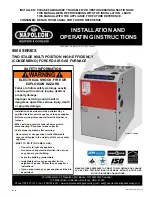
Furnace Installation and Owners Manual
42
LDJ620_E01_R03_2006.03
Models LDJ620-9 and LDJ620-10
AIR DISTRIBUTION SYSTEM INSTALLATION AND SEALING
S
E A L I N G
M
A T E R I A L S
The two primary materials used to seal ducts during installation
are mastic and tapes, although other sealants may also be used
in special applications. Use all mastics, tapes, and other sealants
according to manufacturer instructions. Clean and dry joints,
seams, and openings of oil, grease, and dirt before applying
sealants, especially when using tapes and non-mastic sealants.
Duct insulation does
NOT stop leakage and is NOT a sealing
material; in fact, dirty insulation is a telltale sign of air leakage.
•
Mastics
—Mastics that meet UL Standards 181A or 181B may be
used to seal duct joints. Use mastics labeled UL 181A-M for
fiberglass ducts, UL 181B-M mastics for flexible ducts, and either
for rigid metal ducts and components. Water-based mastics are
preferable to petroleum-based mastics because they have shorter
curing times, easier cleanup, and more “forgiving” application
characteristics. Mastic must not be diluted. Mastic should be
applied liberally over the entire joint between and over mated
surfaces. When using over holes or gaps that are larger than 1/8
to 1/4 inch, apply a thick layer of mastic followed by at least one
layer of fiberglass mesh tape, topped by a layer of mastic that fills
the scrim pattern completely and covers the mesh.
•
Tapes
—Heat-activated and pressure-sensitive tapes that meet
UL Standards 181A or 181B and are marked for use in the
intended application can be used to construct ducts and, in
some cases, seal ducts and other distribution system
components. Heat-activated tape should be labeled UL
181A-H and used only on rigid fiberglass ducts. Use pressure-
sensitive tapes labeled UL 181A-P for rigid fiberglass ducts,
181B-FX for flexible ducts, and either for rigid metal ducts and
components. Pressure-sensitive tape used on rigid fiberglass
ducts should be rubbed firmly until the pattern of the facing
reinforcement shows through the surface of the tape. When
taping traverse joints, wrap the tape three times.
Pressure-sensitive metallic tape with non-butyl adhesive is useful
to temporarily seal air handler access panels that may need to be
opened in the future. When sealing access panels, a card should
be taped to the access panel that says “Please Replace Any Tape
That is Removed” as a reminder to future repair personnel.
Cloth-backed rubber-adhesive (duct) tapes should not be used
because they deteriorate with time and exposure to heat.
Pressure-sensitive metallic tape with butyl adhesive (not
meeting UL Standard 181) can be used to seal metal-to-metal
connections. Cork tape can be used to seal gaps where
refrigerant lines penetrate the air handler unit cabinet.
I N S T A L L A T I O N M A T E R I A L S
F
A S T E N E R S
Mechanical fasteners—screws, staples, and draw bands—
should be used to secure all joints between sections of duct.
Materials intended to seal against air leaks—such as tapes,
mastics, and other sealants—should not be used to hold
sections of duct together except where mechanical fasteners
are not feasible. Ducts should also be well supported so that
joints are not pulled apart or the duct distorted (pinched) so
that its air flow is reduced.
•
Screws
—On transverse joints in round sheet metal ducts that
use sleeves or swedge or crimped fittings, use at least three
metal screws equally spaced around the joint to ensure that
the joint cannot become separated. For vertical connections
made on flexible duct, install at least three screws below the
drawband used to secure the inner lining to prevent slippage.
Duct boots must be mechanically secured to the building
using screws so that the boots do not rely on the ducts for
support.
•
Staples and Tape
—Ducts constructed from fiberglass duct
board should be fastened together using clinching staples on
approximately 2-inch centers and approved pressure-sensitive
tape. Where staples cannot be used, joints should be held
together using approved pressure-sensitive tapes. The tape
should be placed over the seam and 8-inch-long (minimum)
crosstabs taped on each side of the duct with a distance of
12 inches or less between crosstabs.
•
Drawbands
—When joining flexible ducts to each other or to
other types of duct, the flexible duct must be fitted over a
beaded sleeve or collar and attached with drawbands
(UV-resistant nylon duct ties or preferably metal worm-drive
hose clamps, both with a temperature rating of 165°F)—one
drawband to secure the inner lining and a second drawband to
attach the outer insulation jacket.
•
Support Straps
—Round sheet metal ducts suspended in the
air should be supported by hangers at least every 10 feet.
Flexible ducts suspended in the air should be supported at
least every 4 feet by straps that are at least 1½ to 1¾ inches
wide, and they should not sag more than ½ inch for each foot
of distance between the supports. Straps used on flexible
ducts should not constrict the inner diameter of the duct or
cut the outer jacket.



































